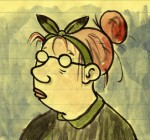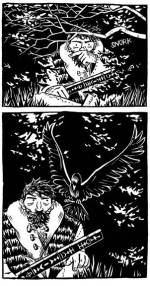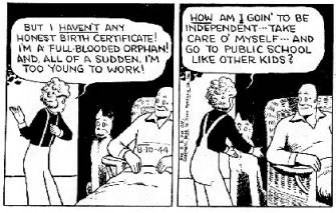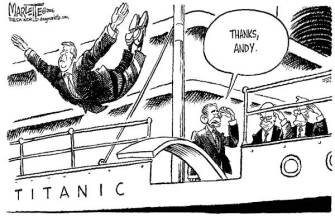
October 27, 2007
 Five Positive Stories About Comics
Five Positive Stories About Comics


Past the occasional message board reply, it's been difficult for me to participate in the latest swirl of hot topics and heated debate and wave of hand declarations that seems to fuel the comics corner of Internet these days. Frankly, I'm at a loss as to what most people are talking about most of the time, although I'm impressed by the confidence with which they speak.
I don't know what this industry needs. I don't care where comics is trending in terms of story or craft or mark-making or autobiography. I don't have anything to say about comics industry journalism except that I'm trying my hardest with the resources I have to do it. I have ethical questions about a lot of industry practices but I'm not totally convinced one way or the other about the majority of them, certainly not enough to stop asking. I don't know which comics are a dead end. I don't have a preference as to how comics are read, who's doing the reading, or where they are when they do it. I don't know why one kind of comics would ever cost another kind of comics their readers. I don't have a specific vision as to where comics should be. I can't tell you comics' future.

What I do know is that this is an extraordinary time to be a comics reader.
The most extraordinary time. And sometimes I think we forget about that. I spent much of my adult life in comics shops every Wednesday looking for something --
anything -- to purchase. Today I have
a 40-item wish list devoted solely to black and white reprints of Marvel and DC comic books. It's been ten years since I bought art from a cartoonist so they could eat, a dozen since I bought comics at a going out of business sale for a store I loved, and five since anyone's told me that the latest
CBLDF beneficiary should go straight to the circle of hell where pornographers go. (To my face, anyway.) While I appreciate a continuing skepticism and an always replenishing desire to make things as ethical and excellent as possible, I remain convinced that things are better than they used to be, and there's no reason to lose sight of that, either.
Here are five stories that make me happy. Maybe they'll make you happy, too.
 We Know What To Do With Joe Sacco Now
We Know What To Do With Joe Sacco Now
I worked for
Joe Sacco's publisher when he was still in the process of making his incredible comic book
Palestine in the mid-1990s. As much as everyone in that publishing house wanted that comic to succeed, it sold poorly, barely enough for
Joe to scrape by. Although the work itself was stunning in so many ways,
Palestine failed to offer readers
superheroes,
indy-comics style fantasy,
humorous satire,
relationship drama or any of the grounds for sales through which the hit comic books at that time had planted their respective flags.

It was only through the publication of a volume in book form that
Palestine began to find its audience. It went on to become a perennial solid seller as
a trade publication. This Fall, Joe Sacco gives us
a special edition of Palestine decked out with as good an author's section on making a great comics work as has ever been published and still anchored by those great, heartbreaking, insightful, lushly drawn and chaotically depicted comics pages, a barely contained howl at the way the world works for millions of people fueled by the passion of a cartoonist working at the outer edge of his talent.
I imagine Joe Sacco will see a much larger check for this new edition than he did when it was a low-selling comic book. He has in one weekend seen more significant press attention. There are more readers who will know how to appreciate the book when they pick it up. There are more stores that will carry it for a longer period of time. All of that makes me happy. Joe Sacco is the kind of cartoonist that deserves Special Editions more than he deserves a low-selling series no one knows quite what to do with. Joe Sacco now has a place in comics, and comics is better for it.
 Craft and Story Are Valued as Never Before
Craft and Story Are Valued as Never Before
I welcome all kinds of comics stories into the marketplace and into the consciousness of critics and editors. A diverse medium is a stronger, richer medium and every incremental broadening of expression is a chance for another kind of reader to engage with the world's greatest art form. At the same time, I can detect no paucity of craft, and certainly no devaluation of story, and I'm confounded by anyone who would argue differently.

The continued ghettoizing of the view that comics hold collectible value independent of content, the commercial rise of art comics, the aging of mainstream comics readers, the bounce-back effect from cross-media interest and the manga invasion all seem to me the kind of things that contribute to a higher baseline for craft considerations among much of the comics audience. If widespread crabbiness is an indication of anything, it's that fans are more demanding than ever, not less. While in the American mainstream the top-selling titles may not always come from the best writers and artists all the time, there's a significant place for people who wear working hard on their chops on their sleeves like
Sean Phillips,
Stuart Immonen,
Matt Fraction,
Ed Brubaker,
Gail Simone and
Alex Maleev. Tons more.
Robert Kirkman.
Ben Templesmith. Further, the discussion of craft now includes a much wider swath of cartoonists. Twenty years ago a discussion of great craftspeople in comics would have centered around, say,
Steve Rude,
Dave Stevens and
Mark Schultz. Now you are much more likely to hear craft arguments on the behalf of artists as disparate as
Charles Schulz,
Darwyn Cooke and
Lynda Barry. The great vanguard of alternative cartoonists from
Jim Woodring to
John Porcellino are marvelous craftsmen. Craft is king.
The land it rules is Story. Young people in every medium have always been fascinated with telling their own tales before most of them turn their voices elsewhere. New playwrights so frequently chronicle what happened to their circle of friends while growing up that there are jokes about it. Screenwriters write screenplays about screenwriters writing screenplays. Songwriters put into song and verse every relationship they had between the ages of 19 and 22. That was bound to happen in comics, too, as greater avenues for expression opened up that weren't bound up in a cape and tights or required to push it away. While there are people that respond to that kind of raw expression, it's rarely the work that drives an art form. It certainly doesn't with comics.

There are so many emerging cartoonists interested in making comics outside of the bounds of autobiography and reportage. The best thus far of his generation,
Kevin Huizenga, makes amazing comics using a classic everyman,
Glenn Ganges.
Zack Soto has introduced us to
Dr. Galapagos, the astonishing
Eleanor Davis seems equally comfortable with
monsters and
lonely people and
Zak Sally has started his readers on a journey with
Sammy the Mouse.
Sammy Harkham came to our attention by looking at the world through the eyes of
a sailor and continues to hold our interest by depicting its reflection in the eyes of
a golem. Ben Catmull gave us an entire town in the first issue of his
Monster Parade.
Mat Brinkman,
Chris Forgues and
Brian Chippendale walked us through richly detailed entire worlds in
Teratoid Heights,
Powr Mastrs and
Maggots.
Frank Santoro and
Ben Jones centered their recent serial
Cold Heat not around a around a depressed twenty-something but a "tri-racial, bi-sexual woman ninja named Castle."
Top Shelf is building a significant portion of their line around genre stories with
foxes,
owls and
super spies as leads.
First Second has a hit with
Sardine, put
comics' greatest autobiographer in touch with
a turn of the century detective agency and took their greatest leap of faith with
a Lost Colony.

We continue to value the stories the more established cartoonists provide. There's still a
Palomar and a
Hoppers and an
Ylum, (not to mention a
Metropolis and a
Latveria).
Usagi Yojimbo and
Groo are still being published (
David Chelsea in Love and
Real Stuff are not). Last year we met
Edison Steelhead (
The Ticking, Renee French) and this year got to spend time in the company of
Percy Gloom (in
Cathy Malkasian's Percy Gloom). The vast majority of manga published in the US to highest-profile success has been long form serial narrative, from
Dragon Head to
Dr. Slump to
Naruto to
Bleach to
Fruits Basket to
The Drifting Classroom to
Anne Freaks. I was in the grocery store the other day and while I was in line I read a part of
a story about a boy possessed by a ghost that plays Go, which I pray to God isn't autobiographical. Comics has a million stories, some of which have only just begun.
I honestly couldn't tell you if there's enough story, or if it's bad if some people don't value story as much as I do. Maybe I'm not looking close enough to see incremental differences of degree, maybe I'm not as taken with certain, classic modes of delivery, I don't know. I do know comics remains stuffed with stories, stories that I'll be reading and telling people about until the day I die, stories that thrill the vast majority of readers who come to the medium, and take up a huge portion of the collective creative class's attention. Story has nothing to worry about. Story rules.
 IDW is Going to Publish Little Orphan Annie
IDW is Going to Publish Little Orphan Annie
No one believes me when I tell them just how much I enjoy
Harold Gray's long-running newspaper strip
Little Orphan Annie at the height of its powers. There's nothing like it in all of comics, in all the artistic world. On a technical level, Gray used white space and spare design in a way that equaled
George Herriman when it came to showing the awesomeness of nature. Gray could also use those same elements to suggest how empty a single room apartment could be, or the loneliness of a mansion's Great Hall when people weren't around to fill it.

As much as it's been reduced in the public mind to an unctuous song or two squeaked out by one of Mommy's special darlings curling up her fists to look cute, Little Orphan Annie's moral character on its best, rightful stage is an astounding thing to behold. My Mom and a million other little girls wanted to be like Annie when they were kids, and reading Gray's strip I soon found out that Mom had chosen far better than I had (either
Hardy Boy). The closest modern analog to Annie in pop entertainment is
Chihiro in Miyazaki's Spirited Away, although Annie's coarser in both character and presentation. Each child works through their problems, finding strength through that hard work. They're both empathic, look out for other people, and remain true to themselves. All the time. You might laugh, but if you take into account the era in which the best Annie adventures took place, there must have been something almost spiritual in its message. Stay honest. Stay true. Keep working. You'll get home.
I don't know where
IDW is beginning
its project, but hopefully they'll be committed until the best work begins, the late '20s and into the 1930s and even the '40s. I never get sick of reading how Annie and her Daddy Warbucks find each other and their fortune, lost more times than I can count. I never get tired of looking at the way Harold Gray carved space from the abyss with only a few lines of ink. I never get tired of these comics. Welcome back, Annie.
 The Editorial Cartoonist Field Bleeding Has Subsided (At Least For Now)
The Editorial Cartoonist Field Bleeding Has Subsided (At Least For Now)
It seems to me that the tenor of talk about the notion of the editorial cartoonist profession going away has changed over the last several months. I suspect that a lot of that change comes from outside events. The
sudden passing of Doug Marlette made a lot of people realize just how loud a noise a successful cartoonist makes within the sound of his voice, whether it's a series of local stages or a national one. The emergence of new-generation stars like
Mike Luckovich and
Nick Anderson are noteworthy in that they both are solid craftspeople who excel within the regional culture in which they're placed, and have obvious value to their publishers.
Tom Toles has by now undeniably become the cartoonist at the
Washington Post everyone hoped he'd be when he stepped in for
Herblock. Giants of the field
Paul Conrad and
Pat Oliphant refuse to fade. The list goes on.

One important development may have been convention-related. The push by several at
this year's AAEC meeting to downplay news of the loss of cartoonists paper to paper and replace it by extolling the positive effects editorial cartoonists have on their publications is not only smart in itself but suggests considered opposition to decay and progressive remedies will come. That has to be an encouragement. For the first time in a while, the last few months paint a picture of editorial cartooning as a field in an adjustment period rather than simply a profession in decline. At some point it was inevitable that the bleeding would stop, that the talent remaining would be so considerable as a group that things would settle into place and would be of such obvious value to their newspapers that no matter how they transform themselves in the next several years it would be clear that cartoonists must be a part of it. I didn't expect the bounce so soon, but if the rally takes place now, that's great news.
 Cromartie High School is Two-Thirds of the Way To Full English Publication
Cromartie High School is Two-Thirds of the Way To Full English Publication
Sometimes I find myself wishing I got to experience the last ten years of translated manga at an age and with a taste for material where more of it might be closer to my heart, the way it must have been great to be an 11-year-old with a sizable allowance in 1962 and the way it was an additionally fun experience to be 14 and ready for indy comics right when indy comics was ready to entertain me. I'm old like that. There's still a ton of manga of which I'm fond, both out of my natural age range and interests (
Dr. Slump) and square within them (
Ode to Kirhito). I can't complain. If I occasionally wish for a certain set of eyes that used to be mine, it's out of greed.
 Cromartie High School
Cromartie High School is one of those rare comics that works for me just like the significant works being translated, but it also has enough appeal for it not to feel totally out of place in the broader range of books finding translation in the US. Unlike some of the other books I find myself more easily enjoying, Cromartie High School with its large band of satirical idiots I get to experience because of its pop effectiveness more than its literary value. It's funny, it's weird, and I find its press against the normative standards of where funny comes from endlessly entertaining and fairly admirable. It's a minor miracle that it's being published here. I have no idea who's joined me in reading the 12 volumes to date, out of a potential 16 or 17 (depending who you talk to), but I'm grateful for whatever demented publishing strategy that has kept it coming out. All of this translated manga is in a way a wonderful bonus in terms of what I ever imagined would be the comics landscape in America, even ten years ago. I can't help but smile a bit at the good fortune.
*****
That's enough for now. I know it's kind of ridiculous to bemoan the state of on-line windbaggery with a post as long as that one. There's just so much to be positive about, and I'm not sure any of it is being emphasized as much as it should be.
Heck, it would be easy to do five more. I'm heartened by the fact that web cartoonists like
Scott Kurtz,
Chris Onstad,
R Stevens and
Nicholas Gurewitch have reached the audiences they have in the way that they have, the true inheritors of the comics self-publishing crown. I'm tickled that
Jeff Smith's Bone seems to have captured that rarest of all creatures: a second audience. I'm glad to read so many people are interested in
Schulz and Peanuts and
Jonathan Ross' televised love letter to Steve Ditko. I'm amazed by the relationship that Garry Trudeau
has managed to forge with military personnel while remaining critical of the current war. I'm impressed by the emergence of next generation of industry icons like
Eric Reynolds,
Joe McCulloch,
Brendan Burford and
Dan Nadel. I root for
Sophie Crumb and
Frank Thorne and
Mark Tonra to continue making comics despite reasons that might make other people stop. I want to live in a town that has one of these new breed comic stores, and its own editorial cartoonist. I've had at least one dream about
White River Junction, Vermont. And the comics. So many comics.
I no longer care as much as I used to if you agree with me about all that's wrong with comics. The greater hope is that you have some interaction with everything that's right.
posted 10:30 pm PST |
Permalink
Daily Blog Archives
November 2019
October 2019
September 2019
August 2019
July 2019
Full Archives


